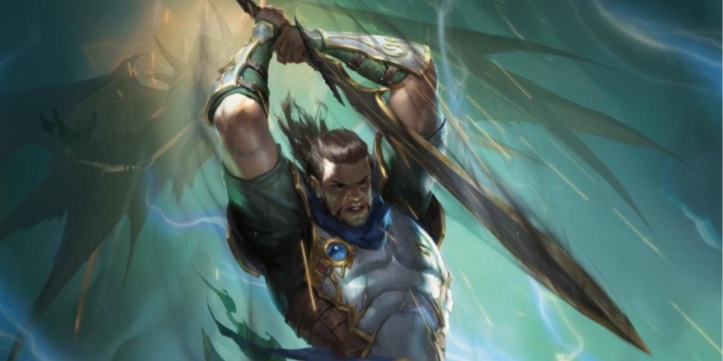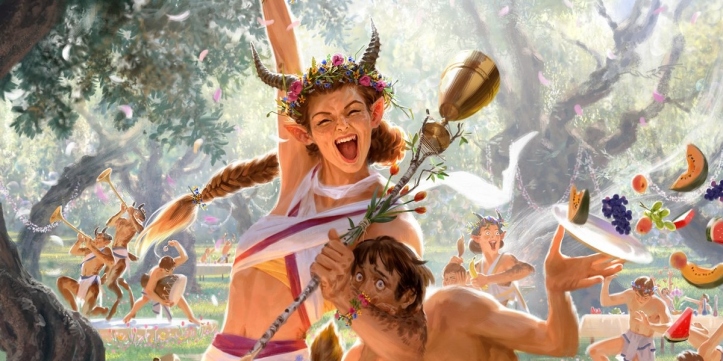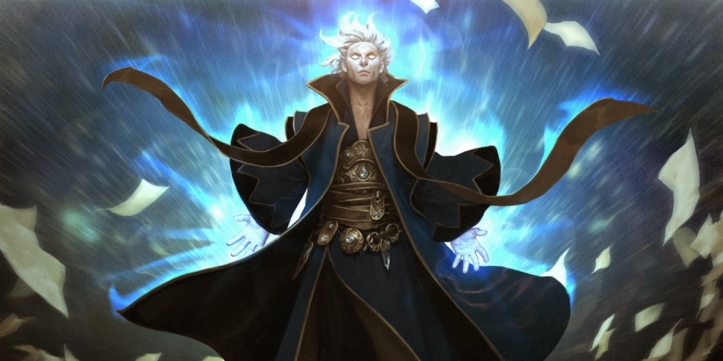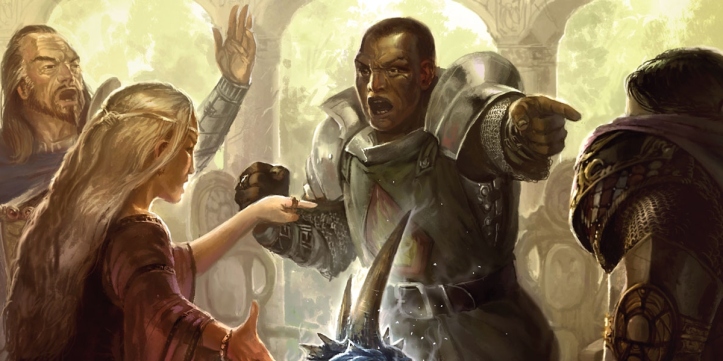Dungeons & Dragons Fifth Edition is a sociable game. Without other players around the table DMing or controlling characters, it would get boring instantly. Its mixture of storytelling and game mechanics risks blurring social norms and creates unique challenges to keeping things harmonious.
Every D&D 5e (and other TTRPG) table knows of the dreaded That Guy. This is the person who shows up at tables looking to win, makes everyone else’s life miserable, and generally spreads malice like a shadowed cloak across the gaming world.
D&D 5e groups are well-served steering clear of That Guy and his hordes of misery. However, that doesn’t mean all social issues at a TTRPG can be avoided.
Not all blunders, missteps, and bad D&D 5e habits are intentional. Sometimes, players genuinely mean well, but it doesn’t come across as such. This can be due to overexcitement, naivete, or simply not quite grokking the norms of a game.
Here are some common examples to avoid.
Optimising (or Neglecting Optimisation) Against the Table’s Norms

It’s very difficult (but not impossible) to maliciously build a D&D 5e character. For the vast majority of players, it’s the chance to flex their creative muscles, breathe life into the campaign’s story, and make something to show off to their friends.
Optimisation is a hot-button issue at many D&D 5e tables. There is nothing wrong with creating an optimal character. By the same token, there is nothing wrong with forgoing the best race and class options in D&D 5e.
Indeed, both of these often have benevolent motives. Many optimisers in D&D 5e want to help their party tackle difficult challenges and walk away alive. Many non-optimisers want to flex the system’s flexibility and possibly make things easier on the DM.
The bad D&D 5e player behaviour comes when one player is out of step with the others.
An optimised D&D 5e character at a non-optimised table will blitz through challenges, throw game balance entirely skew-wiff, and risk invalidating other characters.
A non-optimised character at a table of optimisers will fail to pull their weight, risk compromising others’ builds, and still have a ruinous effect on the DM’s ability to balance.
Obviously, few characters will be perfectly balanced against each other. D&D 5e balance is better than many previous editions, but not flawless. Use your common sense and judge if your build is likely to over- or under-perform.
As hyped as you might be for your D&D 5e Hexadin build that can do eight thousand damage (and I bet they rule), do wait for a table where that’s roughly on par (or find some way to bring it down while retaining the core character concept).
If you want to explore your 8 Strength, 12 Dexterity D&D 5e Barbarian’s journey of personal growth, that’s awesome. But maybe not in a high-level table doing Tomb of Annihilation.
Jumping Into Scenes And Stepping on Other People’s Toes

D&D 5e is fundamentally a group storytelling game, like most other TTRPGs. There is no one main character. Players instead work together to tell a tale where they are all the protagonists and all, ideally, get as much spotlight as is far.
This means that most scenes in a D&D 5e game can involve the whole group. However, this isn’t a universal rule.
Some scenes, conversations, or individual moments are meant for one D&D 5e player (or a subset of the group) above the others. If this is the same character consistently, there might be a problem. However, these often get spread around fairly.
The important thing in these situations for other players is to not jump in and risk taking the spotlight away from the player enjoying it.
There are many benevolent reasons to jump in. A player might have a hilarious quip or line for a conversation. Alternatively, their character’s abilities might add the perfect finishing touch to a plan. The player might simply be enjoying the scene so much that they want their character to be a part of it.
That doesn’t always mean your D&D 5e character needs to be there. It’s an understandable impulse, but sometimes it’s fine to be an audience. If one character is having a significant backstory moment, wait for their input to jump in. If two player characters are having a major conversation, give them space to breathe.
I’m not going to pretend to be an improv master (or even a student). Nonetheless, some things are just good table etiquette in D&D 5e. Despite your excitement, don’t always try to claim your bit of the spotlight.
Telling Others What to Do in D&D 5e Combat

D&D 5e covers many areas. Nonetheless, tactical TTRPG combat is a significant part of the game. This suits some players better than others, whether it be due to experience, rules knowledge, or personal aptitudes.
If you’re a player who loves D&D 5e combat and is well-versed in it, it’s easy to overstep the mark in your role. You can see the matrix code, visualise a way for another character to turn the tide, save the day, or deal eighty damage with their bonus action.
It is still entirely that player’s right to do something else.
At the end of the day, your authority as a D&D 5e player begins and ends with your character. You are not your party’s out-of-character leader. Each other player has significantly more say over their character’s actions than yours, even if those actions could be game-changing.
This, more than any of the other D&D 5e table behaviours in this article, depends on your group’s specific sensibilities.
Sometimes, players really do get a group tactician role for their D&D 5e party, trusted to come up with good moves for everybody. Often, excited advice, reminders of abilities, or even criticism of poor moves are welcome at a D&D 5e table.
At the very least, most will accept “don’t Fireball me, please, you fool,” in the heat of the moment.
However, if you find yourself telling somebody what they should do in most rounds of D&D 5e combat, do take stock and wonder if you’re overstepping your bounds. As a baseline, people who want help will often ask for it.
Creating Homebrew for Your Super-Awesome D&D 5e Character

Sometimes, the options in D&D 5e character creation aren’t enough for players. Maybe they want to try something new, or maybe they want to create a D&D 5e character inspired by other media.
In this situation, it is always tempting to homebrew. However, this can be another problem player behaviour in D&D 5e.
Now, an important disclaimer. I am an avid homebrewer as a DM. On the player options front, I have created several subclasses. Homebrewing is not always a bad thing in D&D 5e.
However, a player’s understandable desire to make the best character possible, that can only be expressed through their brand-new rules, often runs into problems.
Custom homebrew classes and subclasses in D&D 5e run into many issues with balance, stepping on other classes’ toes, fitting within the lore, and coming across as a special and unique main character who is just better than everyone else.
These risks increase significantly with inexperience with the system or a burning desire for the character to do one specific thing. This is when homebrew most risks being a problem D&D 5e player behaviour.
If you want to do something unusual with your D&D 5e character, check the published options thoroughly. There’s plenty of weirdness there. Otherwise, be prepared for your DM to shut your homebrew down and tell you to play something else.
Always Trying to Trip Up the DM

One of D&D 5e‘s biggest appeals for many players is how open-ended it is. There are no hard limits like you find in a video game. Nothing that absolutely has to happen. No out-of-bounds area with a killbox. No data limitations that force repeated lines of dialogue and a limit to nuance.
This freedom is intoxicating for many D&D 5e players. However, it also leads many to take the opposite extreme. With few limits, many players instead decide to push those boundaries as far as they can.
This might involve taking the most unexpected actions possible to force the DM to improvise. Other players see which direction the DM wants the story to go and deliberately avoid it as much as possible. Others still try and plan the best moves to shut the DM or their monsters down.
This is helped by widespread internet memes. New players often see extreme examples of wacky randomness or off-the-rails D&D 5e plots and try to emulate them.
This is fine in moderation. Part of the beauty of D&D 5e and other TTRPGs comes from how much flexibility they offer, letting the players be part-authors of an incredible story with lots of freedom.
If you try and do it all the time, however, it becomes problem player behaviour at the D&D 5e table. The DM is there to have fun. Always seeking to throw them off is counterproductive and even risks being rude.
Most DMs put in a lot of work to create a compelling story. Don’t throw that away or make them put in vast amounts of extra work for a few laughs.
There is nothing wrong with deviating from the DM’s plans in D&D 5e. Likewise, there is nothing wrong with unexpected moves or completely blindsiding everyone else at the table.
However, if your first instinct is to test the limits at every possible opportunity, consider toning it down until it’s really important. You’re much less likely to be a problem D&D 5e player that way.
These have been five things that might come from players’ genuine love and excitement for the game, but still risk being poor D&D 5e table etiquette. What else risks being That Guy behaviour from somebody who really, really isn’t That Guy?
For other games you still shouldn’t do this stuff in, check out ‘Five Fantasy TTRPGs That Aren’t D&D 5e‘.
Likewise, ‘Five Ways to Find a Dungeons & Dragons Group‘ is the article for you if you don’t yet have a party to anger.
If you’ve enjoyed this article, please do leave a like and check out other Artificial Twenty content. Do share with your friends, although ideally not as a passive-aggressive gesture that they’re doing some of these things. Thanks!